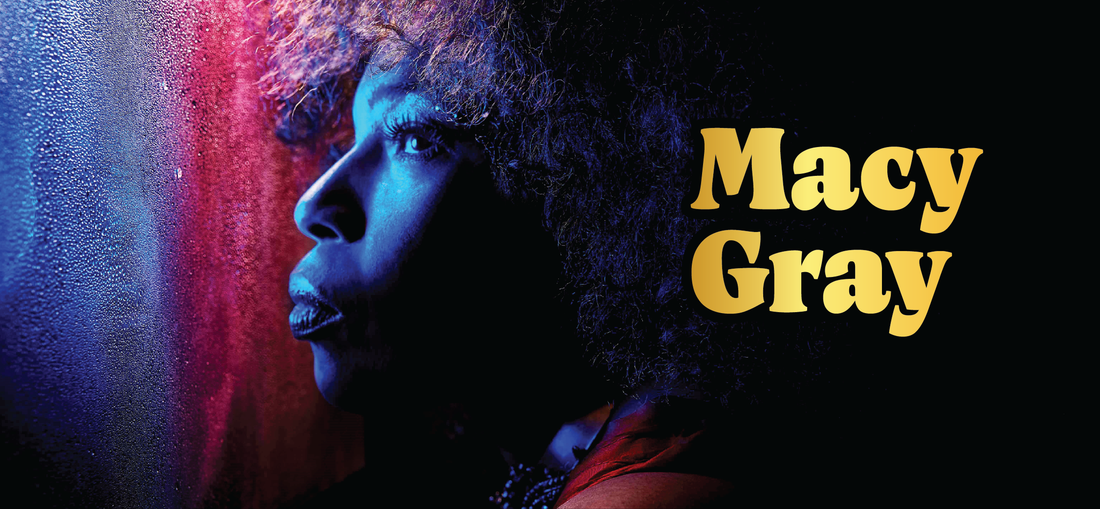
Raspy, Real & Radiant: Macy Gray hits the Riff Main Stage
Share
As a MuchMusic-obsessed elder millennial, I clearly remember Macy Gray’s breakout single “I Try” popping into heavy rotation in 1999/2000. In an era dominated by Britney and boy bands, her signature gravelly, soulful voice was a breath of fresh air—even for a 17-year-old who was more interested in blasting Beastie Boys and wearing out her copy of Nine Inch Nail’s The Fragile on her Shockwave Discman.
There was something immediately different about Gray. Her songs felt more real and vulnerable. Beautiful and imperfect. This was a unique take on soul, funk, and R&B, with obvious influence from the 60s and 70s but also something fresh. And behind it all, that voice; not the belt-it-out diva style of Mariah Carey or Whitney Houston, but a raspy voice that still had range. It captivated my ears and soul—and I wasn’t the only one.
Gray would turn out to be more than a one-hit wonder. With 10 albums that have sold more than 25 million copies, her music had staying power, albeit not without some bumps in the road. She’s collaborated with Ariane Grande, Erykah Badu, Jeff Beck and many other musical powerhouses over the years, and dabbled in acting and reality show appearances.
After the massive success of “I Try” and her debut record, How Life Is, going triple-platinum in the US, Gray—born Natalie Renee McIntyre—won a Grammy and went on to release two more successful records, 2001’s The Id and 2003’s The Trouble with Being Myself. After taking a four-year recording hiatus, she released Big in 2007. Gray has been candid about her struggles with her meteoric rise to fame in the early 2000s.
"I had all that success really early and I don't think I had a plan to make it last," Gray told Oprah during an interview in 2014. "I just kind of took it for granted and assumed that it would be like that for the rest of my life. I pissed a lot of people off and I think I stopped working as hard as I used to."
Gray released the critically middling The Sellout in 2010 and then turned her attention to covers for her 2011 album, simply titled Covers, which features her take on Radiohead’s “Creep”, Sublime’s “Smoke Two Joints,” a frenetic version of “Maps” by the Yeah Yeah Yeahs, and the Eurythmic’s “Here Comes the Rain Again.” Sticking with cover songs, she followed it up with 2012’s Talking Book, covering Stevie Wonder’s album of the same name on its 40th anniversary. Her 2016 record, Stripped, feels like you’re hearing Gray perform in a smoky jazz club; recorded live in an abandoned Brooklyn church, the record meanders through original new songs, reworkings of her older tunes, and a couple jazzy covers, showcasing the talented singer’s jazz chops.
Gray is currently on a 25th anniversary tour of her debut record How Life Is and has teased dropping a new record in July—her first since 2018’s Ruby—so fans can expect some new material alongside her staples like “Sweet Baby,” “Caligula,” and, of course, “I Try.” With setlists including a mix of original classics, innovative covers and her one-of-a-kind voice that, by all accounts, sounds as fresh as it did 25 years ago, Macy Gray’s Friday set at Rifflandia just might be the soulful session Riff-goers didn’t know they needed.
– Amanda Farrell-Low. Amanda Farrell-Low has been covering arts and music in Victoria and beyond for about 20 years now. One day she will come up with a really clever bio. For now, she continues to enjoy the best of culture Victoria has to offer, including Rifflandia, as often as she can, often with her nine-year-old in tow.
